Black Holes: Seeing The Invisible!
Black Holes: Seeing the Invisible!
Black holes are some of the most bizarre and fascinating objects in the cosmos. Astronomers want to study lots of them, but there’s one big problem – black holes are invisible! Since they don’t emit any light, it’s pretty tough to find them lurking in the inky void of space. Fortunately there are a few different ways we can “see” black holes indirectly by watching how they affect their surroundings.

Speedy stars
If you’ve spent some time stargazing, you know what a calm, peaceful place our universe can be. But did you know that a monster is hiding right in the heart of our Milky Way galaxy? Astronomers noticed stars zipping superfast around something we can’t see at the center of the galaxy, about 10 million miles per hour! The stars must be circling a supermassive black hole. No other object would have strong enough gravity to keep them from flying off into space.

Two astrophysicists won half of the Nobel Prize in Physics last year for revealing this dark secret. The black hole is truly monstrous, weighing about four million times as much as our Sun! And it seems our home galaxy is no exception – our Hubble Space Telescope has revealed that the hubs of most galaxies contain supermassive black holes.
Shadowy silhouettes
Technology has advanced enough that we’ve been able to spot one of these supermassive black holes in a nearby galaxy. In 2019, astronomers took the first-ever picture of a black hole in a galaxy called M87, which is about 55 million light-years away. They used an international network of radio telescopes called the Event Horizon Telescope.

In the image, we can see some light from hot gas surrounding a dark shape. While we still can’t see the black hole itself, we can see the “shadow” it casts on the bright backdrop.
Shattered stars
Black holes can come in a smaller variety, too. When a massive star runs out of the fuel it uses to shine, it collapses in on itself. These lightweight or “stellar-mass” black holes are only about 5-20 times as massive as the Sun. They’re scattered throughout the galaxy in the same places where we find stars, since that’s how they began their lives. Some of them started out with a companion star, and so far that’s been our best clue to find them.

Some black holes steal material from their companion star. As the material falls onto the black hole, it gets superhot and lights up in X-rays. The first confirmed black hole astronomers discovered, called Cygnus X-1, was found this way.
If a star comes too close to a supermassive black hole, the effect is even more dramatic! Instead of just siphoning material from the star like a smaller black hole would do, a supermassive black hole will completely tear the star apart into a stream of gas. This is called a tidal disruption event.
Making waves
But what if two companion stars both turn into black holes? They may eventually collide with each other to form a larger black hole, sending ripples through space-time – the fabric of the cosmos!

These ripples, called gravitational waves, travel across space at the speed of light. The waves that reach us are extremely weak because space-time is really stiff.
Three scientists received the 2017 Nobel Prize in Physics for using LIGO to observe gravitational waves that were sent out from colliding stellar-mass black holes. Though gravitational waves are hard to detect, they offer a way to find black holes without having to see any light.
We’re teaming up with the European Space Agency for a mission called LISA, which stands for Laser Interferometer Space Antenna. When it launches in the 2030s, it will detect gravitational waves from merging supermassive black holes – a likely sign of colliding galaxies!

Rogue black holes
So we have a few ways to find black holes by seeing stuff that’s close to them. But astronomers think there could be 100 million black holes roaming the galaxy solo. Fortunately, our Nancy Grace Roman Space Telescope will provide a way to “see” these isolated black holes, too.

Roman will find solitary black holes when they pass in front of more distant stars from our vantage point. The black hole’s gravity will warp the starlight in ways that reveal its presence. In some cases we can figure out a black hole’s mass and distance this way, and even estimate how fast it’s moving through the galaxy.
For more about black holes, check out these Tumblr posts!
⚫ Gobble Up These Black (Hole) Friday Deals!
⚫ Hubble’s 5 Weirdest Black Hole Discoveries
Make sure to follow us on Tumblr for your regular dose of space: http://nasa.tumblr.com.
More Posts from Starry-shores and Others

50 Foot Long Congo Snake
In 1959 Remy Van Lierden was flying over the Katanga region in the Democratic Republic of the Congo. He was flying a helicopter and returning to the base that he commanded in Kamina. As he passed over a clearing in the jungle he noticed a large animal laying out in the sun. What he saw was a 50 foot long snake, with green and brown scales. He couldn’t believe his eyes and neither could his passengers. He circled around and made several passes off the monstrous snake, however he flew away when it got into the striking position and thought it was too dangerous to contour to fly over the animal. During one of the passes he made a passenger on his aircraft snapped this picture to prove what they saw. The snake in question is clearly large and it’s easy to see how it could have been a threat to a low flying helicopter. It’s believed that the snake is a Titanoboa which is thought to be extinct, and has been for millions of years. But it’s possible that the species may have survived. The natives claim that the snake pictured here is a small one and that they can get up to twice and three times the size.
Ten interesting facts about Uranus
Like the classical planets, Uranus is visible to the naked eye, but it was never recognised as a planet by ancient observers because of its dimness and slow orbit. Sir William Herschel announced its discovery on 13 March 1781, expanding the known boundaries of the Solar System for the first time in history and making Uranus the first planet discovered with a telescope.

Uranus is the seventh planet from the Sun. It has the third-largest planetary radius and fourth-largest planetary mass in the Solar System. Uranus is similar in composition to Neptune, and both have different bulk chemical composition from that of the larger gas giants Jupiter and Saturn.

(The five largest moons of Uranus) Like all of the giant planets, Uranus has its share of moons. At present, astronomers have confirmed the existence of 27 natural satellites. But for the most part, these moons are small and irregular.

Uranus’ moons are named after characters created by William Shakespeare and Alexander Pope. These include Oberon, Titania and Miranda. All are frozen worlds with dark surfaces. Some are ice and rock mixtures. The most interesting Uranian moon is Miranda; it has ice canyons, terraces, and other strange-looking surface areas.

Only one spacecraft in the history of spaceflight has ever made a close approach to Uranus. NASA’s Voyager 2 conducted its closest approach to Uranus on January 24th, 1986, passing within 81,000 km of the cloud tops of Uranus. It took thousands of photographs of the gas/ice giant and its moons before speeding off towards its next target: Neptune.

Uranus has rings: All the gas and ice giants have their own ring systems, and Uranus’ is the second most dramatic set of rings in the Solar System.

Uranus makes one trip around the Sun every 84 Earth years. During some parts of its orbit one or the other of its poles point directly at the Sun and get about 42 years of direct sunlight. The rest of the time they are in darkness.
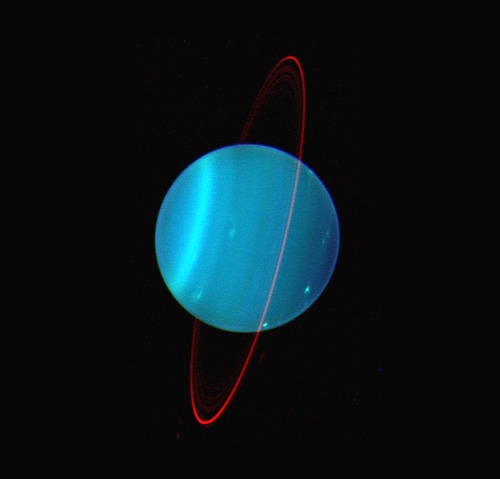
All of the planets in the Solar System rotate on their axis, with a tilt that’s similar to the Sun. In many cases, planet’s have an axial tilt, where one of their poles will be inclined slightly towards the Sun. But the axial tilt of Uranus is a staggering 98 degrees! In other words, the planet is rotating on its side.

Uranus is approximately 4 times the sizes of Earth and 63 times its volume.

Uranus is blue-green in color, the result of methane in its mostly hydrogen-helium atmosphere. The planet is often dubbed an ice giant, since 80 percent or more of its mass is made up of a fluid mix of water, methane, and ammonia ices.

Uranus hits the coldest temperatures of any planet. With minimum atmospheric temperature of -224°C Uranus is nearly coldest planet in the solar system. While Neptune doesn’t get as cold as Uranus it is on average colder. The upper atmosphere of Uranus is covered by a methane haze which hides the storms that take place in the cloud decks.
source
source
source
Images credit: NASA/ wikipedia

New research into the minds of crows has revealed a jaw-dropping finding: the canny corvids aren’t just clever - they also possess a form of consciousness, able to be consciously aware of the world around them in the present. In other words, they have subjective experiences.
This is called primary, or sensory, consciousness, and it had only previously been demonstrated in primates - which means we now may have to rethink our understanding of how consciousness arises, in addition to reconsidering the avian brain.
“The results of our study opens up a new way of looking at the evolution of awareness and its neurobiological constraints,” said animal physiologist Andreas Nieder of the University of Tübingen.
Continue Reading.




Bioluminescent Plankton
Scientists have only recently discovered that this type of plankton glows when they are moved because of stress - ironic when you consider how relaxing the sight of the shimmering waves are in the dark night. Bioluminescence is used as a defence mechanism to draw predators towards the creature trying to eat the plankton. The tiny flashes of light also disorientate and surprise the predator.
These tiny organisms produce light using a chemical called luciferin. The process of creating a bioluminescent light, which is simply light produced within a living creature, differs between organisms. Some need a particular food or another creature for the effect to happen. But this type of plankton, called dinoflagellates, produce luciferin on their own. The light the tiny plankton emit is called ‘cold light’, meaning less than 20% of the light generates heat.
Huge areas of the ocean can become populated by glowing plankton but the effect is especially common in warm-water lagoons that have narrow openings to the sea. This causes the plankton to gather and become trapped, causing the water to turn orange.
Image credit: Will Ho, Kin Cheung, Landscapes Maldives & eyegami
Source: Kuoni
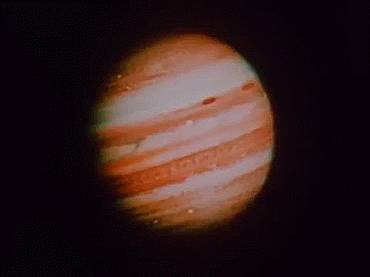
Jupiter seen by NASA’s Voyager spacecraft
Animation taken from video: Jeff Quitney



Captain’s Log | September 15, 2017
The end is now upon us. Within hours of the posting of this entry, Cassini will have burned up in the atmosphere of Saturn … a kiloton explosion, spread out against the sky in a pyrrhic display of light and fire, a dazzling flash to signal the dying essence of a lone emissary from another world. As if the myths of old had foretold the future, the great patriarch will consume his child. At that point, that golden machine, so dutiful and strong, will enter the realm of history, and the toils and triumphs of this long march will be done.
For those of us appointed long ago to undertake this journey, it has been a taxing 3 decades, requiring a level of dedication that I could not have predicted, and breathless times when we sprinted for the duration of a marathon. But in return, we were blessed to spend our lives working and playing in that promised land beyond the Sun.
My imaging team members and I were especially blessed to serve as the documentarians of this historic epoch and return a stirring visual record of our travels around Saturn and the glories that we found there. This is our gift to the citizens of planet Earth.
So, it is with both wistful, sentimental reflection and a boundless sense of pride in a commitment met and a job well done that I now turn to face this looming, abrupt finality.
It is doubtful we will soon see a mission as richly suited as Cassini return to this ringed world and shoulder a task as colossal as we have borne over the last 27 years.
To have served on this mission has been to live the rewarding life of an explorer of our time, a surveyor of distant worlds. We wrote our names across the sky. We could not have asked for more.
I sign off now, grateful in knowing that Cassini’s legacy, and ours, will include our mutual roles as authors of a tale that humanity will tell for a very long time to come.

A rendered view of the night sky from a planet in a globular cluster. Source: Reddit
“To go into solitude, a man needs to retire as much from his chamber as from society. I am not solitary whilst I read and write, though nobody is with me. But if a man would be alone, let him look at the stars. The rays that come from those heavenly worlds will separate between him and what he touches. One might think the atmosphere was made transparent with this design, to give man, in the heavenly bodies, the perpetual presence of the sublime. Seen in the streets of cities, how great they are! If the stars should appear one night in a thousand years, how would men believe and adore; and preserve for many generations the remembrance of the city of God which had been shown! But every night comes out these envoys of beauty, and light the universe with their admonishing smile.”
— Ralph Waldo Emerson, Nature (1836) | I. Isaac Asimov, in Nightfall, had a very different take.
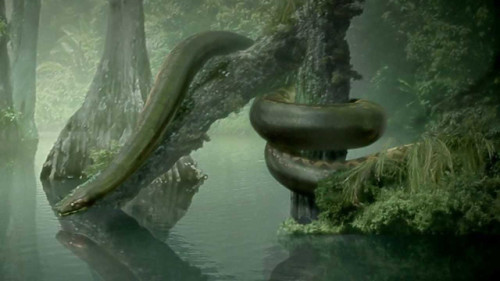

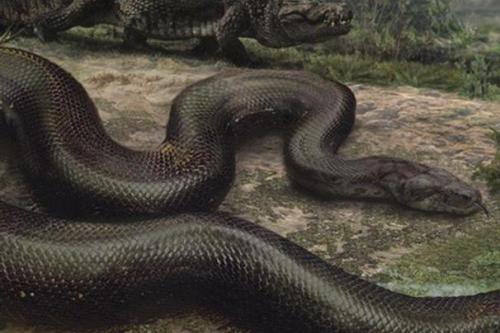
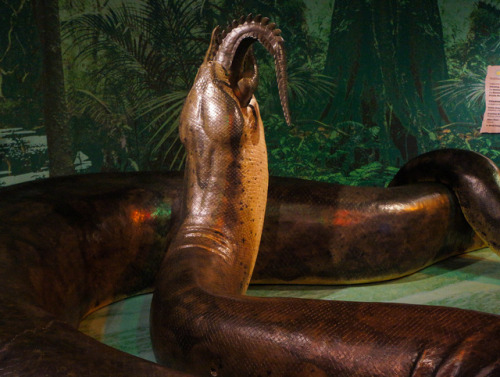


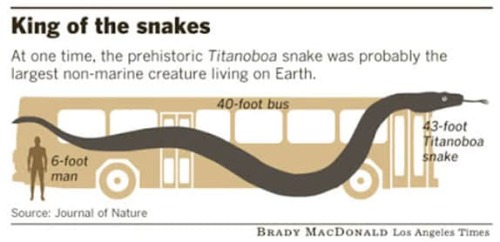
Titanoboa
Titanoboa is an extinct genus of snakes that is known to have lived in present-day La Guajira in northern Colombia. The giant snake lived during the Middle to Late Paleocene epoch, a 10-million-year period immediately following the Cretaceous-Paleogene extinction event.
The only known species is Titanoboa cerrejonensis, the largest snake ever discovered. By comparing the sizes and shapes of its fossilized vertebrae to those of extant snakes, researchers estimated that the largest individuals of T. cerrejonensis found had a total length around 42 feet and weighed about 2,500 pounds.
While initially thought to have been an apex predator of the Paleocene ecosystem in which it lived, evidence has pointed to the genus being predominantly piscivorous. Titanoboa’s massive size would have made it difficult to move on land, so the giant snake would probably have spent most of its life in the water, hunting for fish and other aquatic prey.
Okay, the title of The Atlantic’s article might be a little click-bait-y. But the discovery is truly remarkable. A new bone has been analyzed from the already-famous cave in Russia, and it belonged to, per DNA analysis, the daughter of a Neanderthal mother and a Denisovan father.
-
 marci-redfield liked this · 1 month ago
marci-redfield liked this · 1 month ago -
 ginkgo-leaves reblogged this · 4 months ago
ginkgo-leaves reblogged this · 4 months ago -
 vortikose liked this · 1 year ago
vortikose liked this · 1 year ago -
 blackholesunshineandrainbows liked this · 1 year ago
blackholesunshineandrainbows liked this · 1 year ago -
 itsgerges reblogged this · 1 year ago
itsgerges reblogged this · 1 year ago -
 itsgerges liked this · 1 year ago
itsgerges liked this · 1 year ago -
 stitchlingbelle reblogged this · 1 year ago
stitchlingbelle reblogged this · 1 year ago -
 reecewykes liked this · 1 year ago
reecewykes liked this · 1 year ago -
 plougasthreadnew liked this · 1 year ago
plougasthreadnew liked this · 1 year ago -
 reolitreace liked this · 1 year ago
reolitreace liked this · 1 year ago -
 cozy-queen-of-hats liked this · 1 year ago
cozy-queen-of-hats liked this · 1 year ago -
 pazzesco reblogged this · 1 year ago
pazzesco reblogged this · 1 year ago -
 serrantsaloto reblogged this · 2 years ago
serrantsaloto reblogged this · 2 years ago -
 serrantsaloto liked this · 2 years ago
serrantsaloto liked this · 2 years ago -
 jameswebb-discoveries reblogged this · 2 years ago
jameswebb-discoveries reblogged this · 2 years ago -
 d123456789d123 reblogged this · 2 years ago
d123456789d123 reblogged this · 2 years ago -
 michaellumos liked this · 2 years ago
michaellumos liked this · 2 years ago -
 sharicat liked this · 2 years ago
sharicat liked this · 2 years ago -
 floater2022 liked this · 2 years ago
floater2022 liked this · 2 years ago -
 tigerstripes1227 liked this · 2 years ago
tigerstripes1227 liked this · 2 years ago -
 bibottomnudist liked this · 2 years ago
bibottomnudist liked this · 2 years ago -
 freedomfighterdash liked this · 2 years ago
freedomfighterdash liked this · 2 years ago -
 intothewildsstuff liked this · 2 years ago
intothewildsstuff liked this · 2 years ago -
 roguemortal reblogged this · 2 years ago
roguemortal reblogged this · 2 years ago -
 whatareyoureallyafraidof reblogged this · 2 years ago
whatareyoureallyafraidof reblogged this · 2 years ago -
 mona-vainy liked this · 2 years ago
mona-vainy liked this · 2 years ago -
 starstark liked this · 2 years ago
starstark liked this · 2 years ago -
 umbler22 liked this · 2 years ago
umbler22 liked this · 2 years ago -
 felicigra liked this · 2 years ago
felicigra liked this · 2 years ago -
 muundaanee liked this · 2 years ago
muundaanee liked this · 2 years ago -
 helder-meireles liked this · 2 years ago
helder-meireles liked this · 2 years ago -
 abyssus-abyssum-invocat-m-d liked this · 2 years ago
abyssus-abyssum-invocat-m-d liked this · 2 years ago -
 dedarising liked this · 2 years ago
dedarising liked this · 2 years ago -
 07-passerby liked this · 2 years ago
07-passerby liked this · 2 years ago -
 river-pebble liked this · 2 years ago
river-pebble liked this · 2 years ago -
 doniddb-blog reblogged this · 2 years ago
doniddb-blog reblogged this · 2 years ago -
 doniddb-blog liked this · 2 years ago
doniddb-blog liked this · 2 years ago -
 filkovaariik liked this · 2 years ago
filkovaariik liked this · 2 years ago

Amateur astronomer, owns a telescope. This is a side blog to satiate my science-y cravings! I haven't yet mustered the courage to put up my personal astro-stuff here. Main blog : @an-abyss-called-life
212 posts
